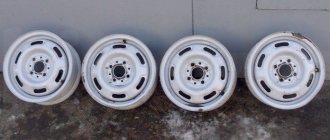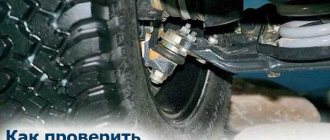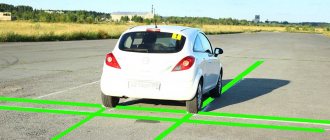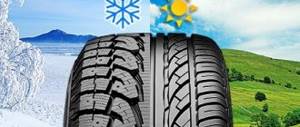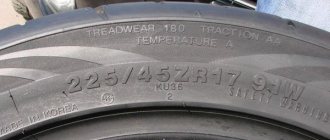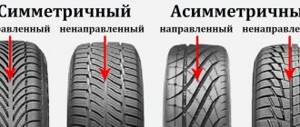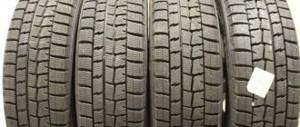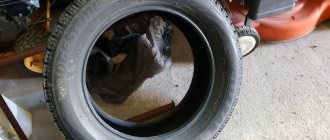I found some useful information on tires, I’ll post it here so I don’t forget it later. Well, maybe it will be useful to someone else. So:
Go to your car and read the inscription on the sidewall of the tire (rubber).
It’s called a standard size and, for example, it looks like this:
205/55 R16 94 N XL
205 is the tire width in mm.
55 - Proportionality, i.e. ratio of profile height to width. In our case it is 55%. Simply put, with the same width, the larger this indicator, the higher the tire will be and vice versa. Usually this value is simply called “profile”.
Since the tire profile is a relative value, it is important to take into account when selecting tires that if instead of size 205/55 R16 you want to install tires with size 215/55 R16, then not only the width of the tire will increase, but also the height! Which is unacceptable in most cases! (except for cases when both of these standard sizes are indicated in the car’s operating book). You can calculate exact data on changes in external wheel dimensions in a special tire calculator.
If this ratio is not specified (for example, 185/R14C), then it is equal to 80-82% and the tire is called full-profile. Reinforced tires with this marking are usually used on minibuses and light trucks, where a large maximum load on the wheel is very important.
R stands for radial tire (in fact, almost all tires are made this way now). Many people mistakenly believe that R- means radius of the tire, but this is precisely the radial design of the tire. There is also a diagonal design (denoted by the letter D), but recently it has practically not been produced, since its performance characteristics are noticeably worse.
16 — wheel (disk) diameter in inches. (It’s the diameter, not the radius! This is also a common mistake). This is the “fitting” diameter of the tire on the disk, i.e. This is the inner size of the tire or the outer size of the rim. You can read more about disc marking in the disc marking section.
H is the tire speed index. The larger it is, the higher the speed you can drive on a given tire (in our case IS - N - up to 210 km/h). Speaking about the tire speed index, I would like to note that with this parameter the tire manufacturer guarantees normal operation of the tire when the car is constantly moving at the specified speed for several hours.
Speed index table:
Speed index JKLMNPQRSTUHV VR Max. Speed (km/h) 100 110 120 130 140 150 160 170 180 190 200 210 240 >210 WY ZR 270 300 >240
94 - load index. This is the level of maximum permissible load on one wheel. For passenger cars, it is usually done with a reserve and is not a decisive value when choosing tires (in our case, ID - 94 - 670 kg). For minibuses and small trucks, this parameter is very important and must be observed.
Tire load index table:
Load index 60 61 62 63 64 65 66 67 68 69 Max. Load (in kg) 250 257 265 272 280 290 300 307 315 325
Load index 70 71 72 73 74 75 76 77 78 79 Max. Load (in kg) 335 345 355 365 375 387 400 412 426 437
Load index 80 81 82 83 84 85 86 87 88 89 Max. Load (in kg.) 450 462 475 487 500 515 530 545 560 580
Load index 90 91 92 93 94 95 96 97 98 99 Max. Load (in kg.) 600 615 630 650 670 690 710 730 750 775
Load index 100 101 102 103 104 105 106 107 108 109 Max. Load (in kg) 800 825 850 875 900 925 950 975 1000 1030
Load index 110 111 112 113 114 115 116 117 118 119 Max. Load (in kg) 1060 1090 1120 1150 1180 1215 1250 1285 1320 1360
Load index 120 121 122 123 124 125 126 127 128 129 Max. Load (in kg) 1400 1450 1500 1550 1600 1650 1700 1750 1800 1850
Attention! The load index in the table is indicated for one vehicle wheel. To calculate the maximum permissible weight of a car, you need to multiply the maximum load weight of one wheel by the number of wheels (for example, for a passenger car you need to multiply by 4).
American designations: standard size (decoding).
There are two different markings for American tires.
The first is very similar to the European one, only the letters “P” (Passanger - for a passenger car) or “LT” (Light Truck) are placed in front of the standard size. For example: P 195/60 R 14 or LT 235/75 R15.
And another tire marking, which is fundamentally different from the European one.
For example: 31x10.5 R15 (corresponds to European standard size 265/75 R15)
31 is the outer diameter of the tire in inches. 10.5 - tire width in inches. R is a radial tire (older tire models had a diagonal design). 15 is the inner diameter of the tire in inches.
Generally speaking, apart from the unusual inches for us, the American tire markings are logical and more understandable, unlike the European ones, where the tire profile height is not constant and depends on the width of the tire. And here everything is simple with decoding: the first number of the standard size is the outer diameter, the second is the width, the third is the inner diameter. To convert one type of standard size to another, you can use a tire calculator - inches.
Color marks used to mark the tire:
The yellow tire marking (circular or triangular mark) on the sidewall indicates the lightest spot on the tire. When installing a new tire on a rim, the yellow mark must be aligned with the heaviest place on the rim. This is usually where the nipple attaches. This allows for improved wheel balancing and lighter weights. On used tires, this yellow marking is not so relevant, since, as a rule, when the tire wears out, its balance shifts.
Red marking (red dot on the tire) means the place of maximum force heterogeneity, the manifestation of which is usually associated with various connections of different layers of the tire during its manufacture. These irregularities are completely normal and all tires have them. But usually only those tires that are included in the original equipment of cars are marked with red dots, i.e. when the car leaves the factory. This red mark is combined with white marks on the disks (white marking marks on the disks are also placed mainly for the original equipment of the car), which indicate the closest place to the center of the wheel. This is done so that the maximum heterogeneity in the tire has a minimal impact when driving, providing a more balanced power characteristic of the wheel. During normal tire fitting, it is not recommended to pay attention to the red marking of the tire, but to be guided by the yellow mark, aligning it with the nipple.
Nokian in Russia
In Russia, the Nokian company is located in Vsevolozhsk. This plant has been here for 13 years and is the largest among other tire manufacturers. The company's office is located in the same city. It resolves issues related to doing business not only in Russia, but also in Kazakhstan and Belarus.
On average, about 15 million tires are produced here per year. Only half of them remain in Russia, and the remaining half are exported. The company is one of the top manufacturers not only in Russia, but throughout the world.
Nokian's main plant is located in Finland. This is where the company's history began. Some models for Russia are produced in Finland.
Where are Dunlop wheels made?
Although the concern originated in England, a large number of enterprises produce rubber under the Dunlop brand:
- Dunlop India - India;
- Dunlop Tires South Africa - South Africa;
- Dunlop Tires – Japan 25%, USA 75%.
The latter supplies wheels to Russia. Among the many companies, the main manufacturer has several subsidiaries:
- Remington,
- Sumitomo,
- Pneumant.
Today, Dunlop products are sold on several continents and in nine countries. The largest producers of tires are Americans, Japanese, French and Germans. A plant built in Brazil is currently preparing to begin production.
In Russia, Dunlop wheels are sold in winter and summer versions. Motorists speak only positively about all models. Basically, such tires come from three countries:
- Japan,
- Germany,
- USA.
However, in the car market you can also find tires made in China. The low quality of such products has received a huge number of negative reviews.
How to find out the production date of Nokian tires
Like any other manufacturer, Nokian indicates the release date on the side of the models. Most often it includes four numbers, which are located in an oval stamp. The last two indicate the year of release, and the first pair indicate the week.
For example, if 1807 is indicated, this means that the tires were produced in 2007 in the 18th week - in April. If the models are outdated, then only three numbers will be indicated on them - the first and second indicate the week of production, and the third - the year of production.
However, it is not recommended to buy such rubber, as it loses its properties over time. In general, you should not buy products that were released more than 6-7 years ago.
Trademark (brand), model name, country of manufacture
Trademark (brand) of a tire manufacturer is the name or trademark of the manufacturer. For example, OMSKSHINA, AMTEL-SIBERIA, GOODYEAR, NOKIAN, etc. A corresponding logo may also appear. We have included several images for clarity.
Model name is a trade (commercial, company) name, for example, M-234 “Taganka”, K-183 “Barguzin”, S-135 “Malachite”, I-559, etc. The tire model (tire model name) is a conditional verbal , a digital, alphabetic or combined designation of a tire, referring to one tire or a group of tires united by common design features.
Country of manufacture – country of manufacture of the tire. This marking indicates to us the country where the plant that manufactured the tire is located. For example, Made in Russia, Made in Japan, etc.
How to check the authenticity of Nokian tires
Some motorists, when purchasing Nokian tires, are afraid of running into a fake. In theory, tires can be faked, but in world practice these were isolated cases. The thing is that production requires an enterprise of considerable size.
Accordingly, not everyone who wants easy money is able to start producing counterfeit goods. And although rubber counterfeits have occurred several times, it can still be considered that this is the industry most protected from counterfeiting.
In any case, it is recommended to purchase tires from trusted stores. They must have a license or certificate to sell such products.
To ensure complete safety, it is best to order tires through the official Nokian website. In this case, you will have to pay for delivery, but you can be sure that the purchased product is definitely original.
How to install tires correctly
Most Nokian models have a directional tread pattern. It provides excellent properties, but when installing such tires you will have to tinker, because if the tread is positioned incorrectly, the performance will deteriorate significantly.
The direction of the tires is most often indicated on the side by an arrow. Therefore, it is not difficult to guess how to place them correctly.
For everyone who values safety and comfort when driving a car, Nokian tires are 100% suitable. At the same time, some models are designed to travel at high speed - for those who prefer an adrenaline rush to calmness.
If it is necessary to replace old tires with new ones, all motorists have a question about how to find out their year of manufacture. It can be read on the tire rim, because every manufacturer must indicate the date of manufacture. But there are no uniform standards, so sometimes this can be difficult to do. You can read about where you can find the year of manufacture on tires, their service life and recommended operating conditions in this article.
Tire markings
On each tire you can find a set of signs and designations. At first glance, it may seem that the load parameters, tire design or tire size are very complex. But in fact, any motorist can understand the markings and decoding of a tire. Typically, the following characteristics can be found on tires:
- Tire type - this designation determines whether the tire is tubed or tubeless.
- Tire size - includes several dimensions: width, profile height and inner ring size. Usually indicated in the format 210/55-18.
- Load index - shows the maximum permissible maximum weight that wheels with maximum internal pressure can withstand.
- Manufacturer - this inscription is usually in large and noticeable letters. This indicator is the first thing motorists pay attention to when choosing tires.
- Seasonality - the designation All Season indicates the possibility of year-round use of such wheels.
- Speed index – shows the maximum permissible speed.
- The date of manufacture is usually indicated by a four-digit code, by which you can find out in what month and year the tires were produced.
- Weather Conditions – If you see umbrella markings on your tires, they are most likely designed for wet and rainy weather and have high aquaplaning protection.
What do the numbers on car tires mean?
Their designations are usually deciphered using a special table. Most manufacturers use standard labeling. Most of the data is presented in digital form. Usually on the side of the tire you can find the following groups of letters:
- XXX/XX RXX;
- XXT;
- XXXXXXXX.
For example, a group of numbers like 195/65 R15 means the following:
- 195 – the profile width is indicated in millimeters;
- 65 – profile height (also in millimeters);
- R – type of rubber (radial, other);
- 15 – tire diameter, in inches.
When choosing, you need to focus on the above numbers. The remaining data presented on the rubber is secondary. They only limit the maximum possible speed, as well as all other parameters. Often, many buyers believe that the letter R indicates the radius of the tire. This is one of the most common mistakes. R – tire type, means radial.
In addition to the information presented in digital form, a lot of other information is presented in the form of letter designations. For example, M+S - indicates the possibility of using rubber at any time of the year. This designation indicates all-season use. It is only important to remember: in the presence of ice, safe driving is only possible when using studded wheels.
Tire life
Most drivers know that there are two parts that you shouldn't skimp on in your car: brakes and wheels. Tires are a key element of your safety, as they provide traction and effective braking. Both your health and the service life of the car depend on how high quality and correctly selected they are. Therefore, the issue of choosing tires should always be approached with special care.
Over time, tires wear out, so it is necessary to replace them with new ones in time. It's better to do this a little earlier than to drive on tires that have worn down to the very base of the tread. What is the service life of tires? Of course, a lot depends on the operating conditions. But the maximum permissible period is considered to be 45 thousand kilometers. Experts no longer recommend delaying changing tires. Observing seasonality and careful driving helps to extend the life of wheels.
Why find out the manufacturing date of tires?
So does it make sense to look at the date of manufacture of tires, since the number of kilometers on them is still not displayed? This parameter is worth checking out when purchasing new tires. In this case, it is useful to know when they were made. Due to improper storage, they can deteriorate, and in this case, the newer the product, the better. At the correct temperature conditions, tires can be safely stored for 3-5 years. But before purchasing such products, you need to carefully inspect the tires for cracks, wear and other marks. Ask the seller for a quality certificate to avoid unpleasant situations.
What you need to remember when buying Nokian tires:
- Year of manufacture: a 2 - 3 year old tire should cost less than a new one;
- Models W+ and WR G2 are excellent (as far as possible) all-season options, inferior to winter tires (the same Nokian) in winter and summer. As a compromise solution, it is a good choice; not a single all-season model is so widely represented on the Ukrainian market;
- Nordman tires are good mid-range tires, but at a premium price. It is not clear whether these tires are Nokian tires;
- The HKPL R is truly one of Nokian's best models;
- It only makes sense to buy HKPL 5 and 7 studded and only if you really need studs.
How to find out the year of manufacture of a tire
You can find out when a tire was produced by reading the corresponding marking. Where is the year of manufacture on the tires? Each batch of manufactured products has a four-digit code, which hides the year of manufacture of the car tire. This date is usually located on the tire rim. For convenience, they are often found in an oval stamp, so finding these numbers is not difficult.
The date itself usually consists of three to four digits that indicate the month and year of production. For example, the designation “0815” can be deciphered as follows:
- 08 – the eighth week of the year, i.e. the end of February;
- 15 – year of manufacture.
Thus, after reading this designation, you can immediately understand that the tire was released in August 2020. The four-digit designation was introduced in 2000, so when you see three numbers instead of four, you can immediately understand that such tires were produced in the last century.
Determining the release date
Regulations of the International Transport Organization oblige manufacturers to mark the production date of products on products. This data is written on the side of the tire and is separated from other markings. Since 2000, they consist of four digits located inside an oval stamp: the first two indicate the year-to-date production week number, the last two indicate the year of production. For example, marking 3119 indicates 31 weeks, which corresponds to August 2020.
Before 2000, the production date could be determined by three numbers: the first two indicated the week, the last one indicated the year. Manufacturers limited the life of rubber to 10 years. For example, the number 139 represents the 13th week of 1989 or 1999. The presence of a triangle after the numbers indicates the 90s.
In practice, in order to find out the year of manufacture of tires, you need to look at the side surface and find a combination of four numbers. To quickly determine, you can use online calculators on automobile websites. To do this, you need to enter 4 numbers in a special window. The calculator will display the date in terms of month and year.
Year of manufacture on Japanese tires
On Japanese brand tires, the expiration date is indicated in exactly the same way as on all others. The year of manufacture on Nokian tires is indicated on the side surface, next to the DOT inscription. If you could not find the manufacturing date when purchasing used tires, then it is better to postpone such a purchase, because it is not known how long it has already “lived.” How to find out the years of manufacture of a tire if the date has been erased or is not visible? You can also determine the wear period of tires by eye. By what signs can you recognize old tires?
- Loss of elasticity - if you start to bend the rubber, it will become difficult to give in. The newly released product can be easily bent as the new tires are elastic and more durable.
- The appearance of cracks - the smallest of them may not be visible to the human eye. You can detect them if you bend the tire a little. Such a product has most likely already been used and it is better not to buy it.
- The dark gray color of the tires may also indicate that they are old.
- Violation of geometry is one of the most noticeable signs of improper tire storage. It is also better to refuse such a product, because no one knows how long such “new” tires will last.
How to find out the year of manufacture of a tire
What pressure should the tires have? Tire pressure table
Many car enthusiasts, when purchasing new or used tires, often ask how to determine the year of manufacture of the tire. Everyone knows that, regardless of use, any product gets stale and deteriorates, and tires are no exception. If a driver buys a new product, but it had been in a warehouse for 5 years before being installed on his car, then most likely there are microcracks on the sole and side surface, and the rubber mixture has gradually entered into a chemical reaction with impurities in the air, several worsening traction properties and grip quality.
Tire production date - marking
Therefore, experienced motorists, before purchasing wheels, always carefully study the markings on the product profile, determine the original origin of the tire, ensure compliance with the declared characteristics and, of course, find out the exact date of production, in particular:
If we are talking about new products, then, of course, they should be released in the 21st century, that is, after 2000. It was from this period that tire manufacturers agreed on a new international standard for marking on the side cord of the product, consisting of 4 numbers. In this case, the driver should read the code in 2 digits, and each pair means a specific number: the first two characters are the serial number of the week in the current year, and the second two are the year of manufacture, where it is necessary to imply 20 in front of it
Particular attention should be paid to goods offered on sale at significant discounts, as the seller may well try to disguise defects or temporary wear and tear of tire materials under a low price. So, if a motorist goes into a store and a new original Bridgestone tire in 18 diameter is sold for 5 thousand
rub.* instead of the usual 10-12 thousand rubles, you need to study the production date, since the numbers 3505 or the end of September 2005 are unlikely to add good performance to the tires. For example, if a car enthusiast saw the code 1416 on the side of the wheel, this means that it came off the assembly line in the 14th week of 2020. Here you can calculate that week 14, based on 4.5 weeks a year, shows the production date at the very beginning of April 16. If such a tire is purchased in 2020, then you can safely consider it new, but as of February 2020, the feasibility of the purchase is already being questioned, and the buyer should inquire about the storage conditions of the product.
Correct storage of tires without rims
- How to find out the year of manufacture of a tire? When a driver is going to purchase a used tire or a used car, which he inspects before purchasing, the tires may have been produced before the year 2000 - in the 90s or 80s. True, identifying such products is very simple due to the difference in international marking standards - all wheels produced before the new century had a 3-digit designation.
- Thus, the number 207 represents the 14th week or mid-May of 1988 or 1998. To distinguish the year 80 from the year 90, just look at the nature of the marking - if the three-digit code is written on its own, then this is an older tire, and the triangle after the year designation means production in the 90s.
Important! If the rubber is stored in a warehouse where there are practically no large temperature changes when the seasons change, and it does not experience long-term stress during storage, then the tires can be purchased after 3 years without a doubt that they have lost their basic characteristics. When storage occurs under an open shed or even on the street, you should remember that temperature changes, ultraviolet rays and other negative environmental influences often have a detrimental effect on the product, and you should not purchase tires that have been stored for more than a year. The same applies to storing products under heavy load from dozens of overlying tires - cracks or deformations often appear on the side cords, which will subsequently lead to a sudden rupture of the balloon, swelling due to the formation of a hernia, or the impossibility of 100% balancing
The same applies to storing products under heavy load from dozens of overlying tires - cracks or deformations often appear on the side cords, which will subsequently lead to a sudden rupture of the balloon, swelling due to the formation of a hernia, or the impossibility of 100% balancing.
Improper tire storage
What else should you pay attention to when buying tires?
When choosing new “shoes” for your car, it is important to pay attention not only to the year of manufacture of the tires. There are a number of signs by which you can understand that the product was stored incorrectly:
- Blisters and hernias on the surface of the tire indicate that the tire has already been used. Under no circumstances should you buy such tires, because such new formations cause an imbalance in the tires, which cannot be removed at any tire shop.
- Microcracks on the side - most likely, a product with such problems can no longer be sold due to improper storage or expiration of its service life.
- Traces of welding or sealant indicate that “restorers” have worked on the tire. Some tires can still be retreaded; there are even entire companies that do this. But often vulcanizing pastes used to seal cuts and cracks are ineffective. The tires start to deflate, the car starts to drive, in general, you definitely won’t get any pleasure from driving on such tires.
Even when buying used tires, carefully inspect them for the above signs. If you find at least one of them, postpone such a purchase until later.
Tire size
Tire size is a designation in accordance with the regulatory document. For example: 175/70R13, 195R15, 195R15С, 175-13, 6.45-13, 155/6, 15-13, 6.45-14.5LT, 225/60 R15, where
- 175, 195, 155, 225 – tire profile width in millimeters,
- 6.45 and 6.15 – profile width in inches;
- 13, 14, 14.5 and 15 – tire diameter or outer rim diameter in inches;
- 70, 60 – tire series as a percentage (the ratio of the tread width and the height of the sidewall of the tire; the height divided by the width and multiplied by 100%. It is calculated as follows: take for example the size 195/60R15, where the sidewall height is taken as x. x/195* 100 = 60, that is, in this case, the actual height of the tire sidewall is 117 millimeters);
- if there are no lines or numbers behind the profile width designation (195R15), this means that the tire series is more than 80;
- R stands for radial tire,
- for diagonal tires the letter D is not indicated (6.45-13);
- the letter C identifies a light truck (light truck) tire produced by manufacturers in the CIS countries,
- and LT (Light Truck) - the same, but from manufacturers in the rest of the world;
Tire Size in more detail in the video article section. The material entitled “First (introductory) film” contains a detailed story about the standard sizes of passenger cars (those whose tires have a tread width in millimeters). The second film, entitled “Off-Road Tires,” contains information about tires whose parameters are recorded in inches.
Extending tire life
Tire life depends not only on the year the tire was made, but also on how you store it. After a seasonal tire change, many people send them to collect dust in cold garages, or even worse, on the street. Such treatment reduces the service life of tires by two or even three times. What rules must be followed to ensure that tires serve you for a long time?
- Maintaining the temperature regime is the main condition for the safety of tires. At the same time, low temperatures are not as scary for them as elevated ones. If it is above 25 degrees, the rubber begins to deform at the molecular level, and this negatively affects its performance.
- Optimal humidity is also very important to preserve all the qualities of tires. If the room is too humid, moisture will settle on the surface of the rubber. In such conditions, nothing critical will happen in a couple of months, but if the tires are stored in such a room from year to year, you cannot count on their long service life.
- For storing tires, a vertical position is preferable. Do not stack the tires in a “column” on top of each other. Rubber should also not be left in direct sunlight, as this may cause cracks to appear on the surface.
Determining the expiration date of a tire
Specific dates depend on the quality of the material and storage conditions. For example, the ideal warehouse environment is a dry workshop with no temperature changes, minimal dampness and no direct sunlight. If all parameters are met, the product can be stored for 7-8 and 4-5 years for summer and winter tires, respectively.
More accurate studies were carried out by MICHELIN, Continental and others. Artificial tests confirmed these results and showed that a tire that had been in a warehouse for 2-3 years practically does not differ from a fresh one in terms of characteristics. In 2020, you can take products released after 2014-15. And for products from 2012, the critical moment for write-off has already arrived.
Moreover, the data is relevant exclusively for branded products such as Blizzak Spike 01, Goodyear, Hankuk and analogues of Japanese or European production.
For simple modifications, it is necessary to revise the deadlines downward. At the same time, it is difficult to determine because cheap tires may not be equipped with dates. Therefore, it is necessary to carefully review such factors.
- Appearance – fresh rubber of a rich, black color, no whitish tint or coating.
- The material is soft, elastic, the structure is homogeneous.
- There are no small cracks or tears on the walls and tread of the product.
If all parameters are met, you can ride on the wheel.
Expert advice
There is an opinion among motorists that it is best to buy all tires of the same year, as this will improve the car’s road grip characteristics. But it’s not easy to find tires from different batches with the same release dates, and is it even necessary? Experts say that the year a tire was manufactured has absolutely no effect on its parameters if the product was stored correctly and the deadlines were met. Therefore, if you bought 5-6-year-old tires at a discount at a sale, you should not think that they will not last very long.
It is better to buy such tires from a well-known manufacturer than tires from an unknown brand that have just rolled off the assembly line. Believe me, the former have a better chance of working out their 5-7 years without problems. If you are determined to buy only the best tires, then it is better to take a closer look at the new products on the market. They will definitely be with the latest production date.
Results
When choosing new or used tires, be sure to pay attention to the date of manufacture. How to check the year of manufacture of a tire? You need to pay attention to the color and presence of cracks on the surface of the rubber. Old tires turn from black to gray, and a scattering of cracks can be seen on their surface. If you come across such a product, ask to bring the product from a newer delivery or refuse the purchase altogether. But do not forget about other parameters when choosing tires: evaluate the profile height, make sure that they are exactly suitable for your car. Choose tires taking into account seasonality, store them correctly, and then they will serve you for many years!
How to find out the production date of a tire (month and year of production of the tire)? How can you tell if a tire is too old to be used?
We specifically decided to combine these questions into one section, because if people are interested in the date of manufacture of a tire, then they want to understand at least two questions:
- How suitable are their old tires for further use?
- Is it possible to buy new tires that have been in storage for several years?
Let's start with how to determine the date of manufacture of a tire.
How to determine the year of manufacture of tires
Different countries have their own markings that determine the production date of car tires.
However, in the early 2000s, manufacturers began to adhere to common standards. This has become a necessity due to the proliferation and mixing of products. For example, for foreign brands Kumho, Yokohama, Dunlop, Pirelli, special markings are installed where the exact data is encrypted. Recently, other manufacturers have joined the general standards:
The following is a more accurate determination of the production time of tires from popular manufacturers.
Tire release date: where indicated
According to the regulatory documents of the Department of Transportation, all manufacturers of automobile tires are required to mark the production date on their products. The code should be separated from other designations, which makes it stand out for better identification.
For models from manufacturers such as Goodyear, Michelin, Nokian, the location of the encoding in a separate oval is relevant. The index consists of 4 digits, which makes it easier to find and decipher. For example, you can take Nokian Hakapelita tires of 7/5/8 generations.
In this case, you can see that the index is highlighted with a rubber oval, the numbers stand out among the general designations.
You can also find products on the market with strange indices like YYY 2015/2117 and others. You can find it on the side parts of the tire.
These are typical identifiers for the Yakohama brand.
The following designation can be found from Goodyear:
As you can see from the photo, the code numbers are not surrounded by rubber circles or squares, but are simply written during vulcanization.
Marking the production date of tires and deciphering their designations
As of 2020, there is a generally accepted marking of the production date of automobile tires according to the DOT code. At the same time, the rules are the same for cars, truck tractors and buses.
The side parts on tires of the brands Bridgestone, Michelin, Toyo, Kama contain the so-called DOT coding. The index itself consists of several characters, but in this case the buyer should be interested in the last 4 digits.
Weekly allocations are taken into account in accordance with the ISO 8601 regulation, where calendar allocations are strictly broken down into weekly basis.
Also on some modifications of rubber you can find a designation like “YYY2018” and similar. This is especially often indicated for Yokohama brand products. You should not be afraid when you encounter this marking. The first three letters are not taken into account, the numbers are interesting - 2020 tells the buyer that the product was released from the assembly line in the 20th week of 2020.
“In the bins” of some unique stores you can still find wheels with three-digit indices such as 125 or 129. This is the standard marking of parts manufactured before 2000. However, there is no distribution of winter or summer tires.
There is also a definition of the week and year of issue. To accurately understand the situation, you need to pay attention to the place after the last number. For example, if there is a space or a triangular symbol after the code, this indicates the 90s, and if there are no extraneous marks, the model was released in the 80s.
Tire production date
The tire production date is written on the sidewall of the tire in an oval stamp in the form of 4 digits, for example: 1805. The first two digits indicate the week of manufacture, the last two indicate the year.
In our case, week 18 is April 2005.
To make it easier to calculate the production date, our website “Pokryshka.ru” has a special calculator for calculating the production date of a tire.
Tire manufacturing date calculator
The calculator calculates the tire date only for a 4-digit code.
A tire's 3-digit date code means it was manufactured before 2000.
A 3-digit tire production date code means it was manufactured before 2000.
The old marking is similar to the new one, i.e. the first two digits are also the week of manufacture, but the last digit does not mean the entire year, but only the last digit of the year.
For example, code: 108
. This means that the tire was released: 10th week of 88 or 98.
To understand the 80s or 90s, you need to carefully look at whether there is a space (space or triangular stamp) on the sidewall after these numbers or not.
If: *108*
, then this is '88.
If there is a space after the numbers: *108 *
or
*108
(triangle icon)
*
, then this tire is from the 98th year of manufacture.
Such difficulties are due to the fact that previously tire manufacturers did not think that the tire would be used for more than 10 years. But after 2000, tire manufacturers came to a more convenient 4-digit marking of the production date on the wheel.
3-digit or 4-digit numbers may be preceded by several more letters, for example, or , but to determine the rubber release date we are only interested in the last digits.
You can find out about additional inscriptions on the wheel in the sections: car tire markings and wheel markings.
Production date location
First of all, you should pay attention to the age of the product.
This parameter is indicated closer to the inside of the tire and is indicated by four numbers. It's easy to find out the production date. The decoding is done as follows - the first two digits indicate the week the tire was manufactured, and the last digits indicate the year the product was manufactured. For example, if the number 2711 is on the tires, then the designation is deciphered as follows: the production date of the tire is the 27th week of 2011. If a three-digit code is indicated on tires, this indicates that the year of production of the product is earlier than 2000.
Such tires, produced in the last century, had a three-digit designation, where the last digit indicated the year of production. However, such tires should be avoided - due to their advanced age, the grip properties of the rubber no longer meet the specified requirements. Even if you bought a conditionally new tire that was released so many years ago, it will not be suitable for safe use due to the natural aging of rubber.
Aging of automobile rubber
Tire manufacturers guarantee normal operation of tires for at least 5 years, provided that the tire has not worn out before this time.
However, in practice, high-quality tires can last much longer, while remaining flexible and maintaining their basic performance characteristics.
The aging of rubber depends both on the quality of the tires themselves and on the conditions under which these wheels were used (or stored).
Over the years, tires gradually release chemicals that give rubber elasticity. We can feel this in the form of a smell that is emitted by almost all new rubber products. Aged tires become harder and less elastic.
This process intensifies at high temperatures, high humidity and when direct sunlight hits the rubber surface. Under the influence of sunlight, OZONE is formed from oxygen in the air, which contributes to the rapid aging of the tire.
That is why it is better to store summer or winter tires with special plastic bags for the wheels, which prevent the sun's rays from directly hitting the rubber, and the bags also prevent direct contact of the tire with the atmosphere.
If stored properly, quality tires can remain flexible for up to 7–10 years!
Externally, the aging of a tire can be seen on the sidewall of the tire, where small cracks gradually begin to appear, which become deeper every year. In addition, the color of the tire itself begins to change and becomes more “whitish”, instead of the original black.
If you see these characteristic signs of rubber aging on your wheels, it means it’s time to change them, even though the tread may not be very worn out yet.
Buyers often ask the question: is it worth buying new tires if their release date is more than two or three years ago?
It all depends on the storage conditions and the original quality of the tire. In warehouses, new tires are stored in different conditions, and if temperature conditions and air humidity are met, then new tires can be stored for a very long time, practically without losing their characteristics.
Therefore, before buying a tire, if it was produced several years ago, you need to evaluate its external condition: whether it has characteristic small cracks, whether the tire has lost its elasticity and whether it has changed its color. If the tire looks perfect in appearance, it means it was stored in the right conditions and you can safely buy it. If you find any signs of aging, it is better to ask to change these tires to newer ones or refuse the purchase.
A lot also depends on the tire manufacturer and, accordingly, the quality of the rubber itself. Leading tire companies spend a lot of money on research in this direction and add special “anti-aging agents” to the rubber composition, the composition of which is kept in the strictest confidence.
By buying good tires, say Michelin, Goodyear, or Nokian, you are buying very high-quality tires that, if used properly, will last you much longer than the warranty period - 5 years (provided that they do not wear out earlier due to high mileage).
All other things being equal, try to buy more “fresh” tires, this is a guarantee that the storage conditions of the tires have not been violated for a long time.
However, you should not pay too much attention to the age of tires when purchasing, especially if it is less than two years old.
Practice shows that such tires serve no worse than those that were released just a month ago. And their performance characteristics and durability primarily depend on its original quality, i.e. from manufacturer and model.
